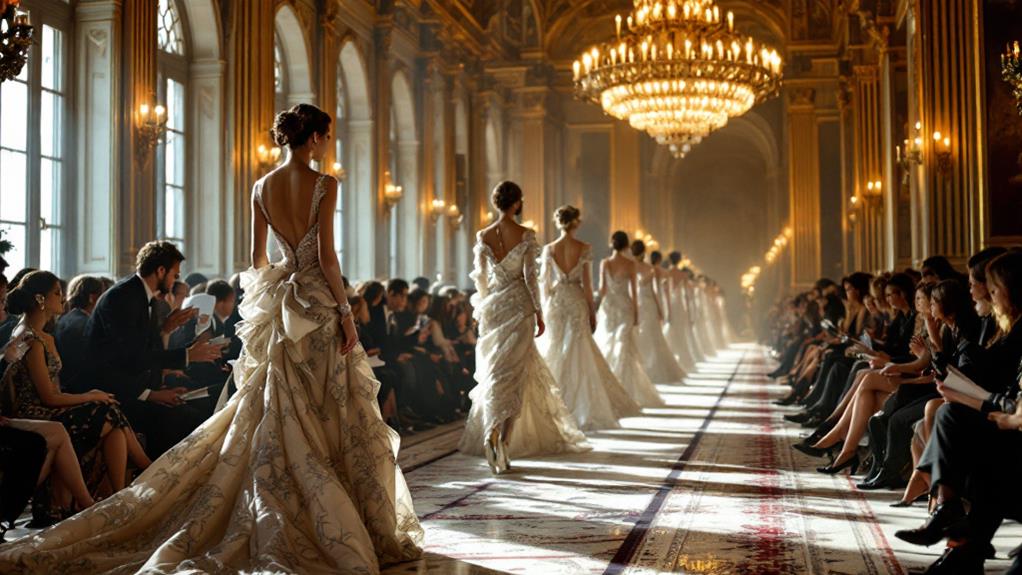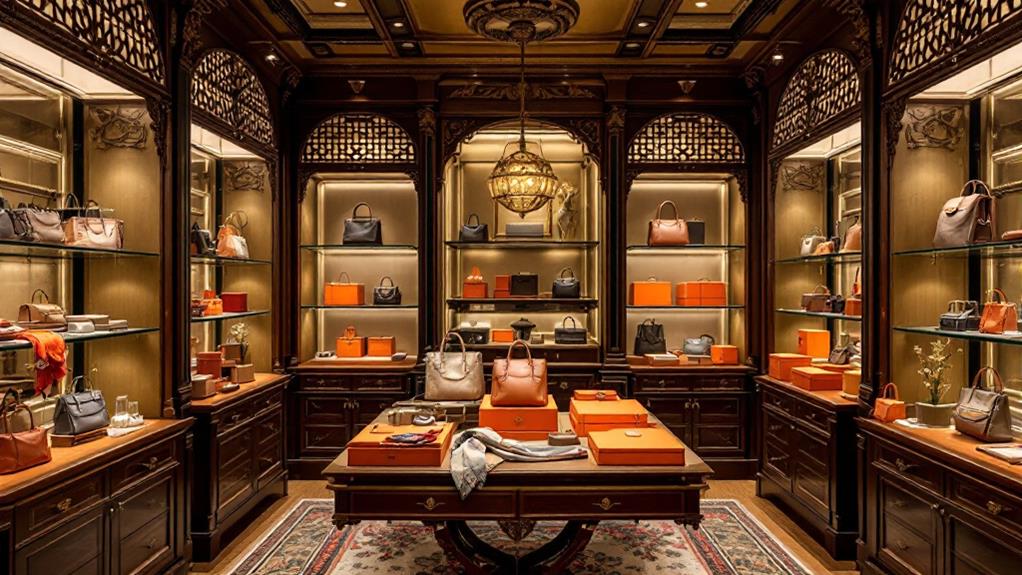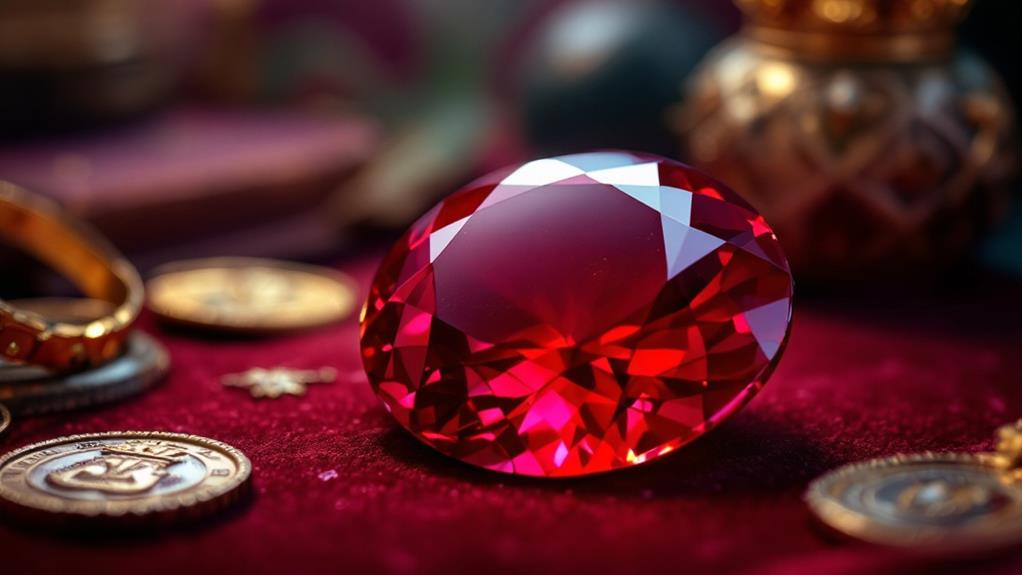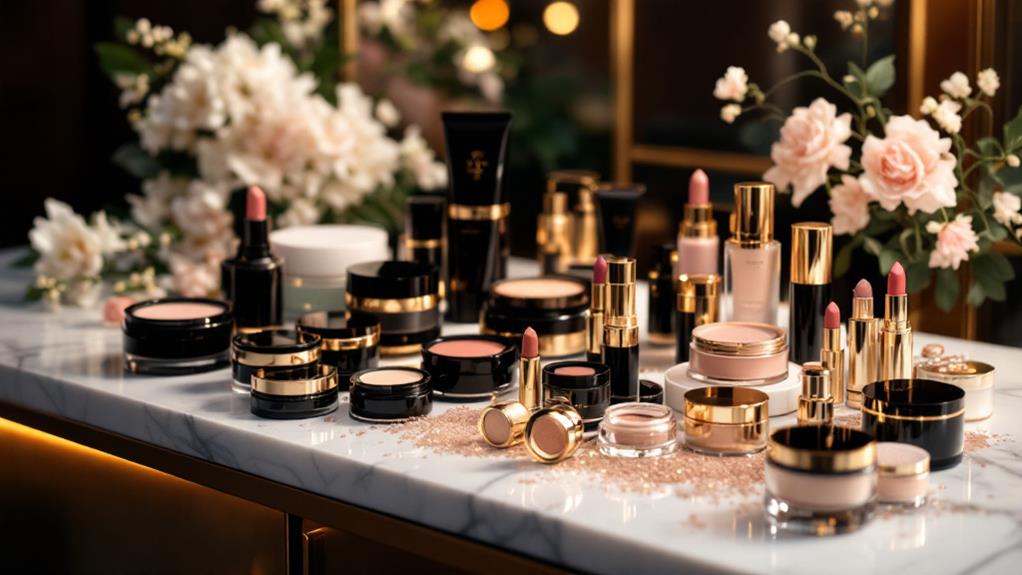The Most Expensive Rugs in the World: History and Luxury
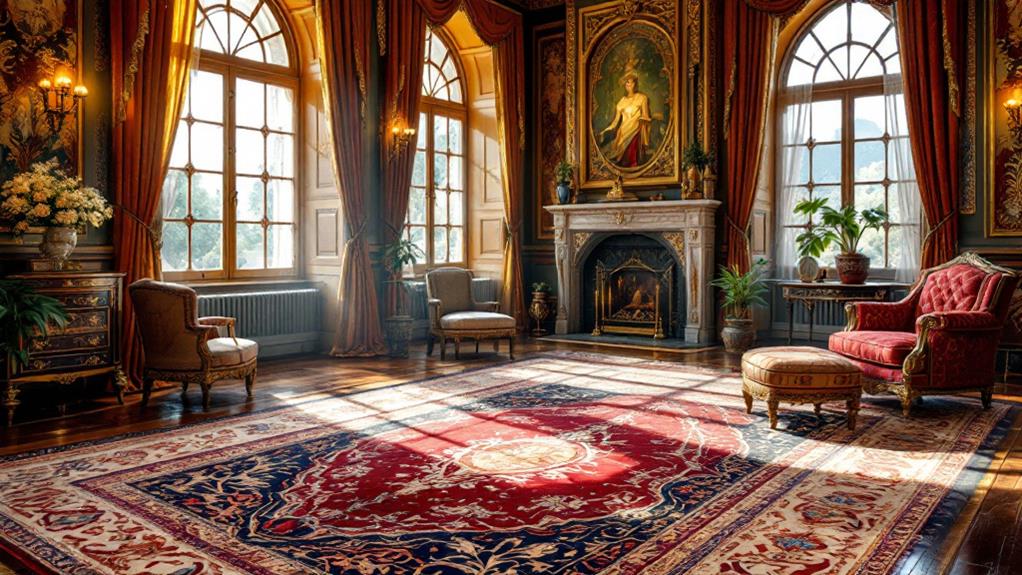
You're venturing into a domain where luxury meets history with the world's most expensive rugs. These masterpieces, often Persian like Tabriz or Kashan, boast intricate designs and high knot counts, reflecting countless hours of hand-knotting using premium materials like wool and silk. Record-breaking sales, such as the Clark Sickle-Leaf Carpet fetching $33.7 million, highlight their immense value. Factors like vintage, rare provenance, and pristine condition influence these prices. Proper care, including gentle cleaning and cautious handling, preserves their worth. Uncover more about notable sales, historical significance, and how to care for and expand a valuable collection.
Art and Craftsmanship
In relation to the art and craftsmanship of rugs, the details speak volumes. When you look at hand-knotted rugs, you're witnessing a labor-intensive process where artisans tie individual knots to warp threads. This careful method can take anywhere from months to years, depending on the complexity of the design. Persian rugs, especially those from Tabriz, are renowned for their intricate designs and historical value. These rugs are not just decorative pieces; they're masterpieces that showcase exceptional craftsmanship.
You can measure the quality of a hand-knotted rug by its knot count per square inch (KPSI). A higher knot count indicates greater detail and craftsmanship, elevating the rug's luxury status. Authentic rugs typically use natural materials like wool and silk, providing durability and aesthetic appeal. Traditional weaving techniques, passed down through generations, guarantee each rug maintains its cultural and artistic significance.
Examining a rug's intricate designs and high knot density is key to recognizing its quality. These elements, combined with the use of natural materials, emphasize the luxury and historical value embedded in each piece. Consequently, when you invest in such a rug, you're acquiring a piece of art that tells a story of tradition and excellence.
Iconic Rug Styles
Among the most iconic rug styles in the world, Persian rugs stand out with their exquisite artistry and craftsmanship. You'll find Tabriz and Isfahan rugs particularly renowned for their intricate designs and thorough attention to detail. These rugs often showcase elaborate floral and geometric patterns, capturing the essence of Persian artistry. Tabriz rugs, for instance, are famous for their high knot count, a proof of their quality and the skill involved in their creation. This superior craftsmanship makes them a prized collector's item among Oriental rugs.
Another Persian gem, the Kashan rug, hails from central Iran and is celebrated for its luxurious materials and striking central medallion motifs. These elements not only improve their visual appeal but also increase their desirability for collectors worldwide. The Kashan rug's detailed designs and luxurious feel make it a standout piece in any collection.
Beyond Persia, other iconic styles like Heriz and Oushak rugs also capture attention. Heriz rugs are known for their bold geometric designs and lively colors, reflecting the rich cultural heritage of the region. Meanwhile, Oushak rugs from Turkey offer soft colors and large-scale floral designs, making them a modern favorite.
Historic Rug Sales
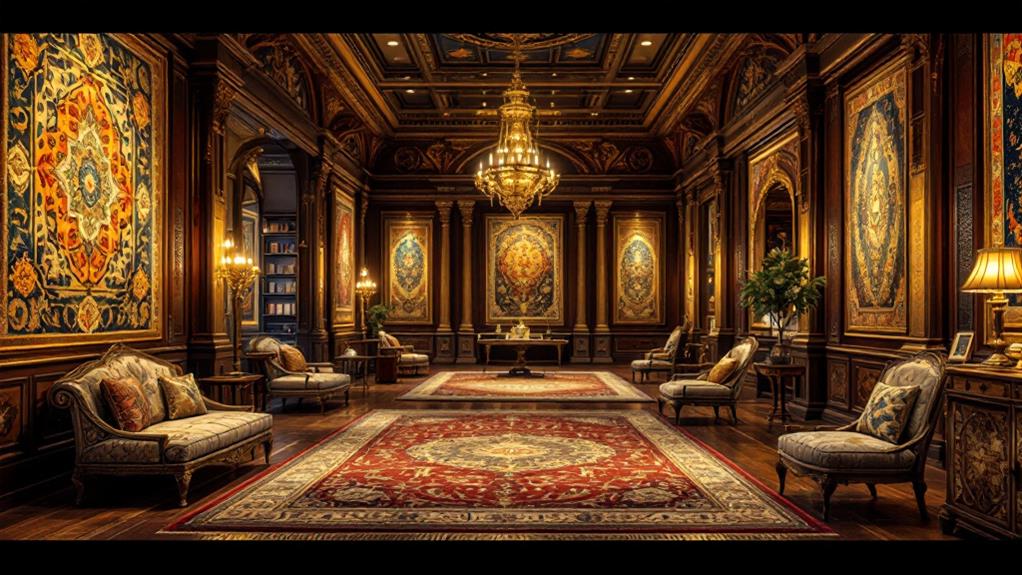
Some of the most breathtaking rugs in history have captured staggering prices at auction, highlighting their timeless allure and extraordinary craftsmanship. The Clark Sickle-Leaf Carpet holds the record for the most expensive rug ever sold, fetching an astonishing $33.7 million at a Sotheby's auction in 2013. Its unique 17th-century sickle-leaf motif exemplifies exceptional craftsmanship and adds to its allure in historic rug sales.
The Kirman Vase Rug, known for its lively floral designs, was another masterpiece that drew significant attention. Originally valued at €900, it sold for €7.5 million at Christie's auction house in 2013, underscoring its immense market appreciation. Likewise, the Pearl Carpet of Baroda, adorned with over a million natural pearls and precious gems, sold for $5.5 million at Sotheby's in 2009, a demonstration of its intricate floral design and royal heritage.
The Mughal Millefleurs Star-Lattice carpet, showcasing Mughal artistry, fetched $7.6 million at Christie's in 2013. Meanwhile, the Silk Isfahan Rug, once owned by philanthropist Doris Duke, achieved a price of $4.45 million at Christie's in 2008, emphasizing the enduring value of exceptional craftsmanship and detailed design in antique rugs.
Factors Influencing Value
When you're considering the value of a rug, several key factors come into play. These elements can turn a simple floor covering into a luxury item worth a fortune.
- Age and Rarity: Older rugs often command higher prices. Their vintage adds historical significance, making them rare and sought after by collectors. A rug's rarity can boost its status, especially if few exist in the world.
- Material Quality: The materials used in a rug greatly influence its value. Rugs crafted from luxurious materials like silk or high-quality wool are more valuable compared to those made with synthetic fibers. Material quality guarantees durability and improves the rug's texture and appearance.
- Provenance: This refers to the documented history of the rug's ownership. Provenance can greatly increase a rug's desirability, particularly if it was once owned by notable figures or featured in historical events.
- Condition and Maintenance History: A well-preserved rug that's been carefully maintained will naturally command a higher price. Collectors look for rugs in excellent condition, as they're more likely to appreciate over time.
Caring for Valuable Rugs
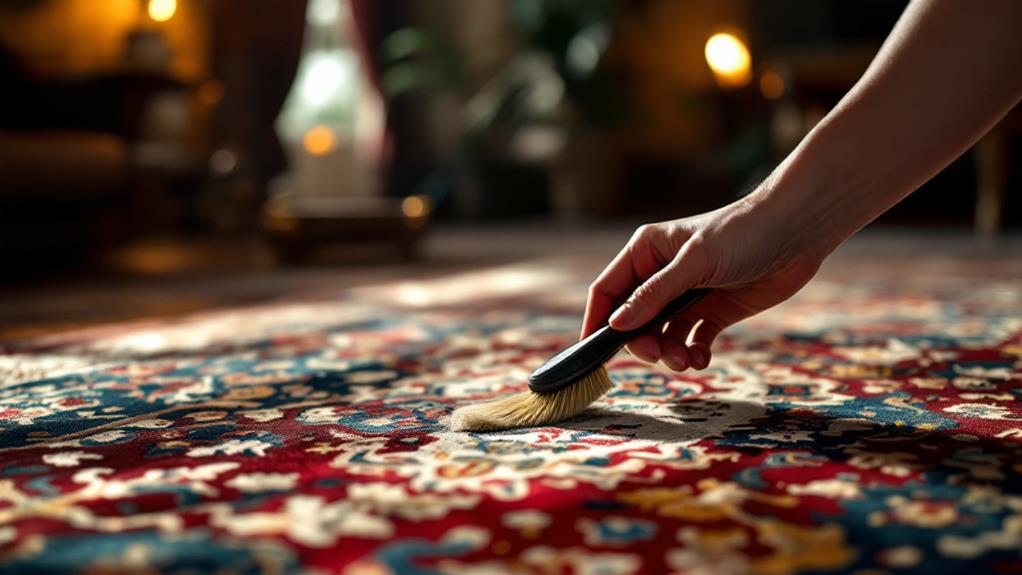
Understanding what makes a rug valuable is just the beginning; maintaining its worth requires proper care and attention. Regular vacuuming on low settings is key to keeping dust and debris at bay without harming the delicate fibers of your prized rug. Aim to vacuum every 1-2 weeks. Don't forget to rotate your rug every 6-12 months to prevent uneven fading from sunlight and foot traffic, guaranteeing its lively colors last longer.
When it comes to spills, act fast! Immediately blot the area with a clean, dry cloth to stop stains from setting. For deeper maintenance, consider professional cleaning every few years to preserve the rug's pristine condition. Rug pads are a smart investment; they provide cushioning and protection against wear, prevent slipping, and greatly extend the rug's lifespan.
If you need to store your rug, confirm proper storage by cleaning it thoroughly initially. Allow it to dry completely, then roll it with the pile facing inward to protect the fibers. These steps offer the best protection against damage while in storage. By following these guidelines, you'll keep your valuable rugs looking exquisite for generations.
Provenance and Authenticity
While exploring the world of high-end rugs, you'll quickly realize that provenance and authenticity are vital factors in determining a rug's value. Provenance, which refers to a rug's documented history of ownership, can greatly improve its worth, especially when linked to notable figures or historical events. Authenticity is similarly important, as genuine pieces from specific regions or artists command higher prices. Imitations, on the other hand, can severely diminish a rug's market value.
To guarantee you're investing in high-quality luxury rugs, consider these steps:
- Verify Provenance: Seek out rugs with clear historical ownership records. Rugs previously owned by famous collectors or tied to important historical moments often attract more interest at auctions.
- Obtain Authenticity Certificates: Established dealers provide these certificates, confirming that the rug you're purchasing is an authentic, high-quality piece.
- Research Dealers: Engage with reputable dealers who can provide detailed provenance records and authenticity certificates, making sure you buy genuine pieces.
- Understand Market Trends: The market for antique rugs increasingly values provenance and authenticity, as collectors are enthusiastic to acquire unique pieces with verifiable histories.
Notable Auctions
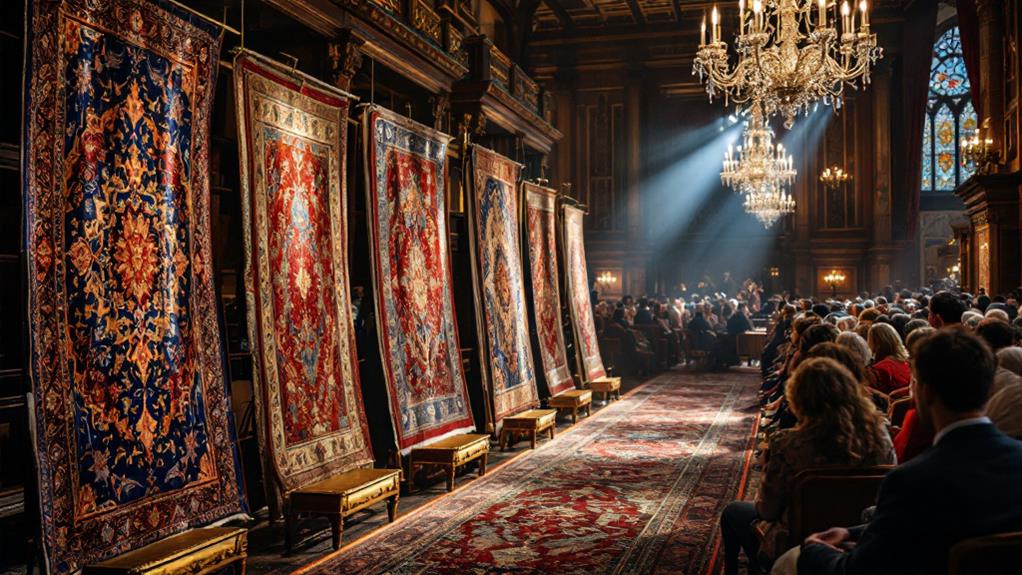
Exploring the high-stakes world of luxurious rugs, you'll find that notable auctions play a significant role in showcasing the value tied to provenance and authenticity. The Clark Sickle-Leaf Carpet, hailed as the most expensive rug, shattered records with its $33.7 million sale at Sotheby's in 2013. This event underscored the immense value that collectors place on antique Persian carpets, especially those with rich histories and exceptional craftsmanship.
Similarly, Christie's has been the stage for remarkable rug auctions. The Kirman Vase Rug, initially valued modestly at €900, experienced a staggering leap to €7.5 million, reflecting the dramatic appreciation these pieces can achieve. Meanwhile, the Mughal Millefleurs Star-Lattice Carpet, an exquisite example of 18th-century North Indian craftsmanship, fetched approximately £4.7 million in 2013.
Sotheby's also hosted the sale of the Pearl Carpet of Baroda in 2009, a masterpiece adorned with over 1.4 million pearls, selling for $5.5 million and highlighting the luxurious craftsmanship involved. Finally, the Silk Isfahan Rug, once owned by philanthropist Doris Duke, was auctioned for $4.45 million at Christie's in 2008, celebrated for its intricate designs and lively colors. These notable auctions demonstrate the allure and extraordinary value of these timeless gems.
Expanding Your Collection
Building an impressive collection of expensive rugs requires a keen eye for provenance and craftsmanship. You should understand that rugs with well-documented histories often rise in value over time. Look for pieces that exhibit high craftsmanship, such as a high knot count (KPSI), which indicates intricacy and quality. Antique rugs are particularly attractive due to their rarity and historical importance, which can greatly enhance their market value and collector interest. Here's a guide to expanding your collection:
- Provenance Matters: Always check a rug's history. Rugs with a rich provenance are often the most expensive rugs ever sold and continue to appreciate.
- Attend Reputable Auctions: Look for auctions at renowned houses like Sotheby's and Christie's, where many high-value pieces are available.
- Seek High Craftsmanship: Focus on rugs with a high knot count and intricate designs, as these qualities indicate superior craftsmanship.
- Consult Experts: Engage with established dealers who understand the nuances of antique rugs. They can offer insights into caring for your collection, ensuring longevity and increased market value over time.

